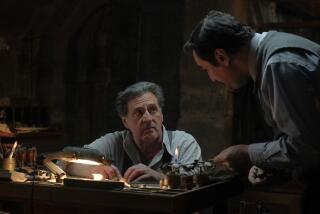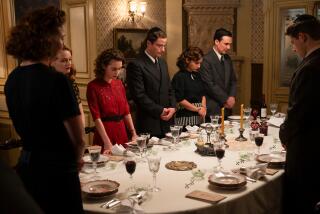Review: ‘Dietrich & Riefenstahl’ raises questions of good and evil

Actress Marlene Dietrich, left, and film director Leni Riefenstahl, are the subjects of Karin Wieland’s new book “Dietrich and Riefenstahl: Hollywood, Berlin and a Century in Two Lives.”
In “Dietrich & Riefenstahl,” German historian Karin Wieland ostensibly compares the lives of two German-born movie personalities, actor Marlene Dietrich and director Leni Riefenstahl. In fact, the true subject of her dual biography is more ambitious: the contrast between good and evil.
The women she profiles were born a year apart (Dietrich in 1901; Riefenstahl in 1902). Neither came from wealth; both studied dance; both worked as actors. But as Adolf Hitler ascended to power in 1933, each made a strikingly different choice. Dietrich defected to the United States, worked in Hollywood and became an American citizen in 1939. She sold war bonds and traveled with the USO through Nazi-occupied France and Italy from 1944 to 1945, overcoming fear, fatigue and primitive conditions to entertain American troops.
In contrast, Riefenstahl embraced the National Socialist government — even as, after the war, she denied having done so. She wanted to direct movies, and leaped at Nazi funding. Riefenstahl is best known for “Triumph of the Will,” a potent propaganda film about the 1934 Nazi Party rally in Nuremburg, and “Olympiad,” about the 1936 Berlin Olympics. During one of her postwar “denazification” hearings, she claimed to have hardly known Hitler — and never to have spent time in the homes of high-ranking Nazis. But in a document identified as the diary of Hitler’s mistress, Eva Braun, Riefenstahl is referred to as “the rival,” who danced for the Führer and received monetary gifts beyond mere financing for her films. Her friendship with Nazi propaganda minister Joseph Goebbels is charted in his journals.
Neither Dietrich nor Riefenstahl were frail. By pairing the two, Wieland explores what they had in common: a determination to survive and to express themselves through film. She juxtaposes their lives chronologically, raising this implicit question: Did the women ally themselves with a particular nation because that nation reflected their authentic selves? Or did the choice itself — Dietrich’s move to America; Riefenstahl’s complicity with the Third Reich — transform them into different people than they would otherwise have been?
Wieland offers no pat answers. But she does imply that the Nazi indifference to human suffering may have enabled Riefenstahl to behave more callously than she could have in the West. Both today and in the past, critics recognized Riefenstahl’s technical prowess and ability to create spectacle onscreen. She opened “Olympia” with aerial footage shot from a balloon and mounted cameras on boat seats, horse saddles and oars. But not all have found it easy to overlook her moral bankruptcy.
Near the end of the war, for example, she began filming “Lowland,” in which she also starred as a Gypsy named Marta. She needed some Mediterranean-looking extras to applaud Marta’s dancing. So she rounded up Gypsy inmates from a concentration camp. They joined her eagerly, hoping that she might intervene to save them from extermination. Instead, after filming them, she blithely allowed them to be packed off to Auschwitz. “This is particularly horrifying in the case of the many gleeful-looking children in the film,” Wieland writes. “In none of her other productions had Riefenstahl demonstrated more clearly that she had no qualms about victimizing people for her own ends.”
Riefenstahl seems all the more sinister because she did not present herself as a stereotypical female Nazi. During the European promotional tour for “Olympiad,” Riefenstahl “did not have a husband or children at her side, did not braid her hair, wore elegant evening gowns and was not averse to having fun,” Wieland writes. But bad timing wrecked her trip to the U.S. She arrived in November 1938, shortly before Kristallnacht, the evening when Nazis torched Jewish businesses and synagogues throughout Germany. Americans could no longer ignore the realities of Hitler. Studios snubbed her.
I wish Wieland had examined Dietrich’s bisexuality as closely as she did the star’s politics. Instead she dwells on Dietrich’s relationships with men, including writer Erich Maria Remarque and French war hero James Gavin. She does, however, explore the masculinity that Dietrich could project onscreen, evident when she played a tough barkeep opposite James Stewart as a less-than-macho cowboy in the 1939 movie, “Destry Rides Again.” “In a reversal of the Western cliché,” Wieland explains, the film’s producer Joe Pasternak “wanted to give the male lead feminine attributes, and the female lead masculine attributes.”
More emphasis on Dietrich’s toughness — not just touring with the USO but battling the diminishments of age — might have created greater symmetry in this biography. Wieland doesn’t ignore Dietrich’s flaws. But Riefenstahl comes off as a lifelong sociopath. Evil here is not banal; it is jaw-droppingly bizarre and eclipses good.
Nor can evil ever fully reinvent itself as good — though Riefenstahl nearly managed to shed her Nazi past in the 1970s, through the 1973 publication of “The Last of the Nuba,” a book of photos of athletic, muscular indigenous people in Sudan. Her shots of the Nuba, Wieland writes, seemed “to illustrate the catchwords of the era: nudity, critique of civilization, art, free sexuality and feminism.” But critic Susan Sontag was not duped. “Although the Nuba are black, not Aryan, Riefenstahl’s portrait of them evokes some of the larger themes of Nazi ideology,” Sontag writes. These include the “contrast between the clean and the impure [and] the joyful and the critical.” (Sontag explains, “A principal accusation against the Jews within Nazi Germany was that they were urban, intellectual, bearers of a destructive corrupting ‘critical spirit.’”)
“No one had expected this kind of attack, least of all Riefenstahl,” Wieland writes. Sontag didn’t condemn the Nazi ideas; she just pointed out that they were central to Riefenstahl’s aesthetic.
Yet some might consider Sontag’s essay an answer to a question raised by Wieland’s book: Did Riefenstahl choose Hitler because his state reflected her core identity or did choosing Hitler turn her into what she became?
Lord is the author of “The Accidental Feminist: How Elizabeth Taylor Raised Our Consciousness and We Were Too Distracted by Her Beauty to Notice.”
::
Dietrich & Riefenstahl: Hollywood, Berlin, and a Century in Two Lives
Karin Wieland
Liveright: 624 pp., $35
More to Read
Sign up for our Book Club newsletter
Get the latest news, events and more from the Los Angeles Times Book Club, and help us get L.A. reading and talking.
You may occasionally receive promotional content from the Los Angeles Times.






